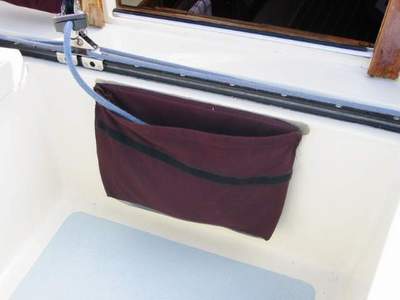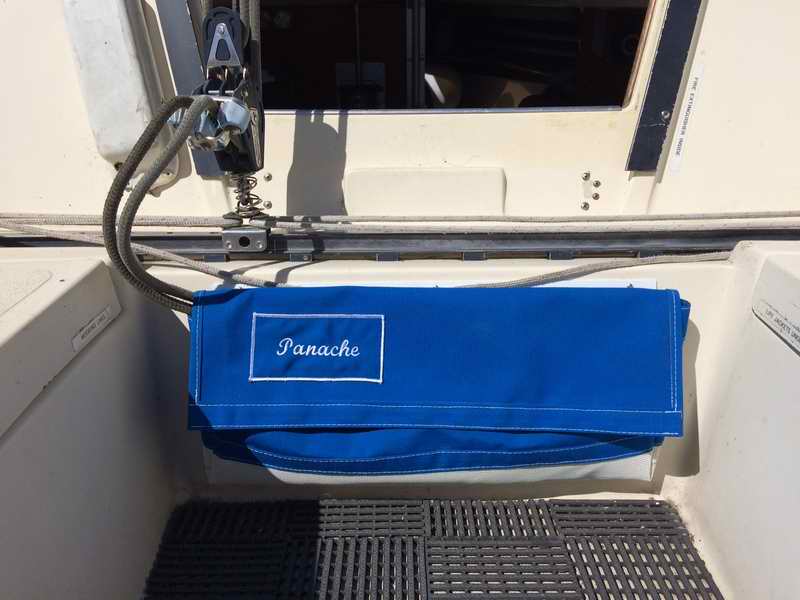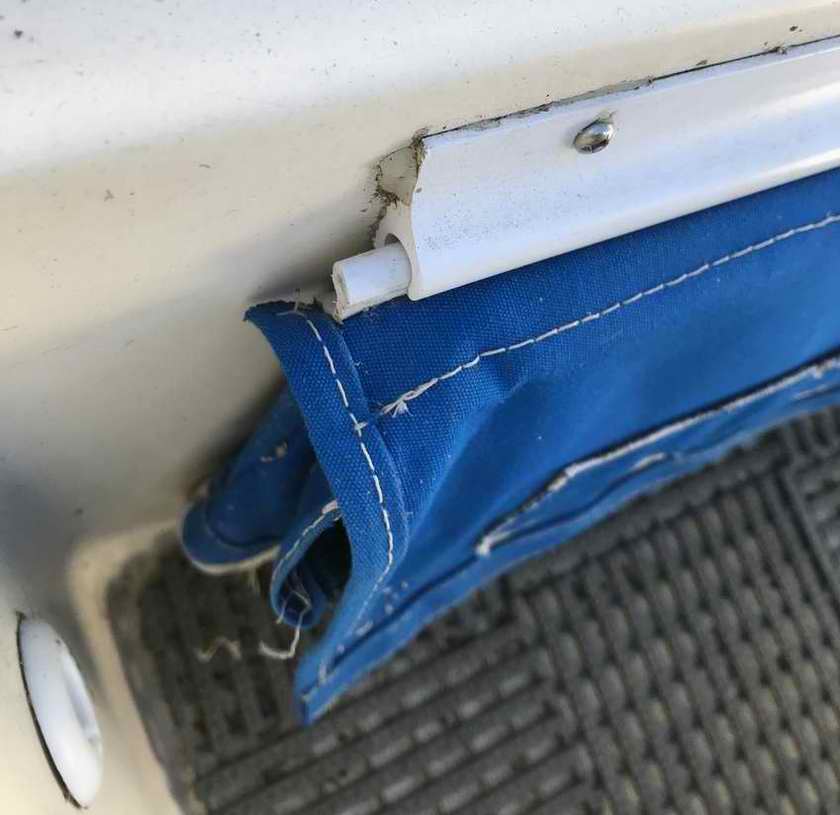| SJ23 Tech Tip F26, (2019-03-16) Bob Schimmel | |
|
Storage Bag for the Main Sheet. |
|
| Q (Quit a few years ago) - "How
do you
folks keep the main sheet from flopping all over the
cockpit floor and out of the way? On
our boat we try to keep the main sheet at the front of the cockpit but
......" Betsy Schultz The cockpit of an I.O.R. designed boat is narrow to favour the rule ratings of the early 1970s. The narrow transom automatically reduces the reserve buoyancy (load carrying capacity) of the stern, making for sensitive fore/aft hull trim. In some circumstances a narrow cockpit is a good feature as it stays drier than a wide one. Best of all, the boat has a better chance of remaining at the surface in a knockdown because the low side of the cockpit is higher above the water. It is also easier to brace yourself to the opposite bench using your legs. On the other hand it is easier to swamp the cockpit with a huge wave over the stern. But never mind, you're not sailing in the Southern Ocean! However, the things you have to deal with in a cramped cockpit means that anything lying about is clutter which is a dangerous tripping hazard, regardless of how few people are in the cockpit. Carry a few novice sailors on board and you'll see what I mean about the cockpit being small. They'll be in the way most of the time because they haven't learned where to be useful or how to stay out of the way. A - An SJ23 is not that big a boat, despite what the brochures will have you believe, so you have to make efficient use of every bit of space there is, especially in the cockpit. Before I had a mainsheet storage bag on Panache I flipped the mainsheet into the cabin simply to clear the cockpit floor of another line to roll under your feet. This works OK if a line doesn't snag on something down there or until the weather or sea state demands sailing with the companionway drop boards in place. MAIN SHEET BAG - The maximum size bag for an SJ23 is (20.5 x 8)". This will cover just about the entire front of the cockpit and allow you to store your binoculars or other valuable stuff as well. Just remember to remove your stuff when it rains or after you arrive at the dock!
I took some designs elements from this bag and made a mainsheet bag from Sunbrella with a phifertex net (a vinyl mesh) at the bottom to let water drip out. It also has a flap at the top to keep the weather out, (should I ever store stuff in there!). The bag is hung from a white vinyl trailer awning track that is screwed and glued to the cockpit wall just above the bag. The awning track has a round slot, similar to the kerf on a mast, that receives the mating vinyl "bolt rope" sewn to the back of the bag. Simply slip the flexible "bolt rope" inside the rigid awning track to hang the bag. Slick and neat without a visible means of support. Below is the bag installed with line stuffed into it. (Order from Sailrite: awning track flanged white #103334, awning rope white vinyl #1371).
FIELD USE - Having a mainsheet bag under the traveler is wonderful. I never realized how nice it is to sail the boat with a cockpit floor free of clutter. No more mainsheet rolling under your foot, no more searching for the end of the line, no more snarled lines and totally out of the way when at anchor. When the boat is on the mooring the wet line is coiled and draped over the bottom block so it can dry. _______________________________________________________ ALTERNATE SOLUTIONS - The following solutions were submitted by fellow SJ23 sailors.
Any of these techniques would work well for cruising. |
|
|
Return to Tech Tip Index. . . . . . . . . . . . . . . Have a Question? |
|

 The bag at right is installed on
my buddy's SJ28. It's equipped with a batten along the top (back) and fastened to the hull with
Velcro along the top
and bottom. Both are required to maintain the form of the bag when
line is stuffed into it. The
bottom of the bag is made of bug screen so a wet line
can drip dry. This bag is also equipped with a flap attached along the back (top)
but is shown here tucked inside for sailing mode. When at anchor, the
flap closes the top and is secured with the Velcro across the front. The
secured flap also prevents the bag from snagging your heel as you step
from the cabin into the cockpit. It can be a tripping hazard.
The cloth matches the mainsail, winch and lifeline covers
for that nice overall look. A very simple and effective homemade design.
The bag at right is installed on
my buddy's SJ28. It's equipped with a batten along the top (back) and fastened to the hull with
Velcro along the top
and bottom. Both are required to maintain the form of the bag when
line is stuffed into it. The
bottom of the bag is made of bug screen so a wet line
can drip dry. This bag is also equipped with a flap attached along the back (top)
but is shown here tucked inside for sailing mode. When at anchor, the
flap closes the top and is secured with the Velcro across the front. The
secured flap also prevents the bag from snagging your heel as you step
from the cabin into the cockpit. It can be a tripping hazard.
The cloth matches the mainsail, winch and lifeline covers
for that nice overall look. A very simple and effective homemade design.
